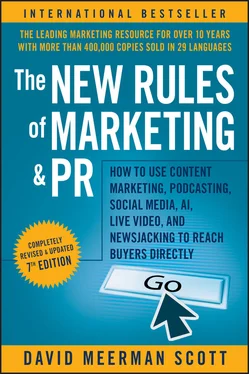1 ...6 7 8 10 11 12 ...24 If you aren’t present and engaged in the places and at the times that your buyers are, then you’re losing out on potential business—no matter whether you’re looking for a job or marketing your company’s product or your organization’s service. Worse, if you are trying to apply the game plan that works in your mainstream-media-based advertising and public relations (PR) programs to your online efforts, you will not be successful.
So take a minute to ask yourself this simple question: How are my existing advertising and media relations programs working?
Advertising: A Money Pit of Wasted Resources
In the old days, traditional, nontargeted advertising via newspapers, magazines, radio, television, and direct mail was the only way to go. But these media make it very difficult to target specific buyers with individualized content. Yes, advertising is still used for megabrands with broad reach and probably still works for some organizations and products (though not as well as before). Guys watching football on TV drink a lot of beer, so perhaps it makes sense for mass marketer Budweiser to advertise on NFL broadcasts (but not for small microbrews that appeal to a small niche customer base to do so). Advertising also works in many trade publications. If your company makes deck sealant, then you probably want to advertise in Professional Deck Builder magazine to reach your buyers (but that won’t allow you to reach the do-it-yourself market). If you run a local real estate agency in a smaller community, it might make sense to do a direct mailing to all of the homeowners there (but that won’t let you reach people who might be planning to move to your community from another location).
However, for millions of other organizations—for those of us who are professionals, musicians, artists, nonprofit organizations, churches, and niche product companies—traditional advertising is generally so wide and broad that it is ineffective. A great strategy for Procter & Gamble, Disney, and a U.S. presidential candidate—reaching large numbers of people with a message of broad national appeal—just doesn’t work for niche products, local services, and specialized nonprofit organizations.
The web has opened a tremendous opportunity to reach niche buyers directly with targeted information that costs a fraction of what big-budget advertising costs.
One-Way Interruption Marketing Is Yesterday’s Message
A primary technique of what Seth Godin calls the TV-industrial complex 4is interruption. Under this system, advertising agency creative people sit in hip offices dreaming up ways to interrupt people so that they pay attention to a one-way message. Think about it: You’re watching your favorite TV show, so the advertiser’s job is to craft a commercial to get you to pay attention, when you’d really rather be doing something else, like quickly grabbing some ice cream before the show resumes. You’re reading an interesting article in a magazine, so the ads need to jolt you into reading an ad instead of the article. Or you’re flying on American Airlines (which I do frequently), and during the flight, the airline deems it important to interrupt your nap with a loud advertisement announcing its credit card offer. The goal in each of these examples is to get people to stop what they are doing and pay attention to a message.
Moreover, the messages in advertising are product-focused, one-way spin. Advertisers can no longer break through with dumbed-down broadcasts about their wonderful products. The average person now sees hundreds of seller-spun commercial messages per day. People just don’t trust them. We turn them off in our minds, if we notice them at all.
The web is different. Instead of one-way interruption, web marketing is about delivering useful content at just the precise moment a buyer needs it. It’s about interaction, information, education, and choice.
Before the web, good advertising people were well versed in the tools and techniques of reaching broad markets with lowest-common-denominator messages via interruption techniques. Advertising was about great “creative work.” Unfortunately, many companies rooted in these old ways desperately want the web to be like TV, because they understand how TV advertising works. Advertising agencies that excel in creative TV ads simply believe they can transfer their skills to the web.
They are wrong. They are following outdated rules.
The Old Rules of Marketing
Marketing simply meant advertising (and branding).
Advertising needed to appeal to the masses.
Advertising relied on interrupting people to get them to pay attention to a message.
Advertising was one-way: company to consumer.
Advertising was exclusively about selling products.
Advertising was based on campaigns that had a limited life.
Creativity was deemed the most important component of advertising.
It was more important for the ad agency to win advertising awards than for the client to win new customers.
Advertising and PR were separate disciplines run by different people with separate goals, strategies, and measurement criteria.
None of this is true anymore. The web has transformed the rules, and you must transform your marketing to make the most of the web-enabled marketplace of ideas.
Public Relations Used to Be Exclusively about the Media
For nearly a decade, I was a contributing editor at EContent magazine. I occasionally write for the HuffPost , contribute guest articles to many other publications, and maintain a popular blog. As a result, I receive hundreds of broadcast email press releases and pitches per month from well-meaning PR people who want me to write about their products and services. Guess what? In 10 years, I have never written about a company because of a nontargeted broadcast press release or pitch that somebody sent me. Think about that: tens of thousands of press releases and pitches; zero stories.
Discussions I’ve had with journalists in other industries confirm that I’m not the only one who doesn’t use unsolicited press releases. Instead, I think about a subject that I want to write about, and I check out what I can find on blogs, on Twitter, and through search engines. If I find a press release on the subject through Google or a company’s online media room, great! But I don’t wait for press releases to come to me. Rather, I go looking for interesting topics, products, people, and companies. And when I do feel ready to write a story, I might try out a concept on my blog first, to see how it flies. Does anyone comment on it? Do any PR people jump in and email me?
Here’s another amazing figure: In more than 10 years, only a tiny number of PR people have commented on my blog or reached out to me as a result of a blog post or a story I’ve written in a magazine. How difficult can it be to read the blogs and Twitter feeds of the reporters you’re trying to pitch? It teaches you precisely what interests them. Then you can email them with something interesting that they are likely to write about rather than spamming them with unsolicited press releases. When I don’t want to be bothered, I get hundreds of press releases a month. But when I do want feedback and conversation, I get silence.
Something’s very wrong in PR land.
Reporters and editors use the web to seek out interesting stories, people, and companies. Will they find you?
Public Relations and Third-Party Ink
Public relations was once an exclusive club. PR people used lots of jargon and followed strict rules. If you weren’t part of the in crowd, PR seemed like an esoteric and mysterious job that required lots of training, sort of like being an astronaut or a court stenographer. PR people occupied their time by writing press releases targeted exclusively to reporters and editors and by schmoozing with those same reporters and editors. And then they crossed their fingers and hoped that the media would give them some ink or some airtime (“Oh, please write about me!”). The end result of their efforts—the ultimate goal of PR in the old days—was the press clip, which proved they had done their job.
Читать дальше












